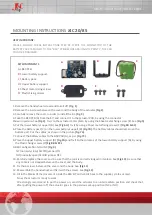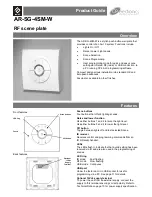
18
SPNU503C – March 2018
Copyright © 2018, Texas Instruments Incorporated
Contents
22.3.3
GIO Block Diagram
...........................................................................................
22.4
Device Modes of Operation
............................................................................................
22.4.1
Emulation Mode
...............................................................................................
22.4.2
Power-Down Mode (Low-Power Mode)
....................................................................
22.5
GIO Control Registers
..................................................................................................
22.5.1
GIO Global Control Register (GIOGCR0)
..................................................................
22.5.2
GIO Interrupt Detect Register (GIOINTDET)
..............................................................
22.5.3
GIO Interrupt Polarity Register (GIOPOL)
.................................................................
22.5.4
GIO Interrupt Enable Registers (GIOENASET and GIOENACLR)
.....................................
22.5.5
GIO Interrupt Priority Registers (GIOLVLSET and GIOLVLCLR)
.......................................
22.5.6
GIO Interrupt Flag Register (GIOFLG)
.....................................................................
22.5.7
GIO Offset Register 1 (GIOOFF1)
..........................................................................
22.5.8
GIO Offset B Register (GIOOFF2)
..........................................................................
22.5.9
GIO Emulation A Register (GIOEMU1)
....................................................................
22.5.10
GIO Emulation B Register (GIOEMU2)
...................................................................
22.5.11
GIO Data Direction Registers (GIODIR[A-B])
............................................................
22.5.12
GIO Data Input Registers (GIODIN[A-B])
.................................................................
22.5.13
GIO Data Output Registers (GIODOUT[A-B])
...........................................................
22.5.14
GIO Data Set Registers (GIODSET[A-B])
................................................................
22.5.15
GIO Data Clear Registers (GIODCLR[A-B])
.............................................................
22.5.16
GIO Open Drain Registers (GIOPDR[A-B])
..............................................................
22.5.17
GIO Pull Disable Registers (GIOPULDIS[A-B])
..........................................................
22.5.18
GIO Pull Select Registers (GIOPSL[A-B])
................................................................
22.6
I/O Control Summary
...................................................................................................
23
Controller Area Network (DCAN) Module
............................................................................
23.1
Overview
..................................................................................................................
23.1.1
Features
........................................................................................................
23.1.2
Functional Description
........................................................................................
23.2
CAN Blocks
..............................................................................................................
23.2.1
CAN Core
......................................................................................................
23.2.2
Message RAM
.................................................................................................
23.2.3
Message Handler
.............................................................................................
23.2.4
Message RAM Interface
......................................................................................
23.2.5
Register and Message Object Access
.....................................................................
23.2.6
Dual Clock Source
............................................................................................
23.3
CAN Bit Timing
..........................................................................................................
23.3.1
Bit Time and Bit Rate
.........................................................................................
23.3.2
DCAN Bit Timing Registers
..................................................................................
23.4
CAN Module Configuration
.............................................................................................
23.4.1
DCAN RAM Initialization through Hardware
...............................................................
23.4.2
CAN Module Initialization
....................................................................................
23.5
Message RAM
...........................................................................................................
23.5.1
Structure of Message Objects
...............................................................................
23.5.2
Addressing Message Objects in RAM
......................................................................
23.5.3
Message RAM Representation in Debug/Suspend Mode
...............................................
23.5.4
Message RAM Representation in Direct Access Mode
..................................................
23.6
Message Interface Register Sets
.....................................................................................
23.6.1
Message Interface Register Sets 1 and 2
.................................................................
23.6.2
Using Message Interface Register Sets 1 and 2
..........................................................
23.6.3
Message Interface Register 3
...............................................................................
23.7
Message Object Configurations
.......................................................................................
23.7.1
Configuration of a Transmit Object for Data Frames
.....................................................
23.7.2
Configuration of a Transmit Object for Remote Frames
.................................................
















































